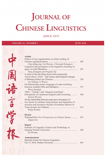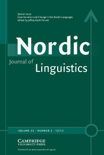
Hrvatski Dijalektoloski Zbornik
Scope & Guideline
Charting the Evolution of Language in Croatia
Introduction
Aims and Scopes
- Dialect Documentation and Analysis:
The journal emphasizes the documentation of various local dialects, including their phonological, morphological, and syntactic features. This includes detailed studies of specific dialects, such as Kajkavian and Stokavian, and their unique characteristics. - Cultural and Historical Context of Dialects:
Research often explores the relationship between dialects and cultural phenomena, including literature, folklore, and historical developments. This aspect highlights how language reflects cultural identity and regional history. - Comparative Linguistic Studies:
The journal publishes comparative analyses of dialects within the Croatian language as well as with other South Slavic languages. This includes examining linguistic features across different dialects and establishing connections between them. - Prosodic and Phonological Research:
A significant focus is placed on the prosodic features of dialects, including intonation, stress patterns, and rhythm. This research contributes to a deeper understanding of the phonological systems in various local dialects. - Dialect Lexicography:
The journal includes studies on the vocabulary and idiomatic expressions of local dialects, enriching the lexicon available for researchers and speakers of Croatian dialects.
Trending and Emerging
- Digital Linguistics and Linguistic Projects:
Projects like the JAPRK (Linguistic atlas of the maritime and fishing culture in Dalmatia and Kvarner) highlight the trend towards using digital tools for linguistic documentation and analysis, indicating a shift towards more collaborative and technology-driven research. - Prosodic Studies:
There is a growing emphasis on prosodic features within local dialects, as seen in several recent articles. This focus is crucial for understanding the rhythmic and intonational aspects of speech, which are often overlooked in traditional dialect studies. - Dialect Variation in Context:
Recent papers are increasingly contextualizing dialect studies within broader socio-cultural frameworks, examining how dialects are used in specific social settings and their role in identity formation. - Morphological and Syntactic Characteristics:
Research on the morphological and syntactic structures of local dialects has gained momentum, reflecting a deeper interest in how these aspects contribute to the overall linguistic landscape of Croatian.
Declining or Waning
- Historical Linguistics of Standard Croatian:
There has been a noticeable decrease in publications focusing on the historical development of Standard Croatian compared to dialect studies. This shift may reflect an increased interest in contemporary dialects rather than their historical evolution. - General Linguistic Theory Applications:
Papers applying general linguistic theories to Croatian dialects have become less common. The journal seems to be favoring more empirical and localized studies over broader theoretical frameworks. - Cross-linguistic Comparisons:
While comparative studies have been a staple, there appears to be a waning interest in extensive cross-linguistic comparisons with non-Slavic languages. The current trend favors in-depth analysis within the Slavic language family.
Similar Journals

REVUE DE LINGUISTIQUE ROMANE
Advancing Knowledge in Linguistic HeritageREVUE DE LINGUISTIQUE ROMANE, published by the esteemed SOCIÉTÉ LINGUISTIQUE ROMANE, is a prominent academic journal dedicated to the exploration of Romance linguistics. With its ISSN 0035-1458, the journal plays a significant role in advancing knowledge within the fields of linguistics and the history and philosophy of science. Although it does not currently offer Open Access, it provides critical insights and peer-reviewed research that are indispensable for scholars, educators, and students interested in the nuances of Romance languages. The journal, which has seen converged coverage from 2006 to 2017, and then again from 2019 to 2021, is ranked in the third quartile (Q3) across various categories within Scopus, reflecting its established presence in the academic community. As a vital resource for interdisciplinary studies, REVUE DE LINGUISTIQUE ROMANE is instrumental for those seeking to deepen their understanding of linguistic structures, cultural nuances, and the historical development of Romance languages.

Lingua Italiana
Illuminating the Depths of Italian Linguistic and Literary TraditionsLingua Italiana is a distinguished journal published by FABRIZIO SERRA EDITORE, dedicated to the exploration and advancement of the Italian language in both its literary and linguistic contexts. With its ISSN 1724-9074 and E-ISSN 1826-8080, Lingua Italiana aims to foster scholarly dialogue among researchers, professionals, and students invested in Italian studies, linguistics, and cultural discourse. Located in Pisa, Italy, the journal provides a platform for rigorous peer-reviewed articles that reflect the latest research, theoretical frameworks, and critical analyses. Although it operates under a subscription model, the journal remains an invaluable resource due to its commitment to quality content and comprehensive coverage of contemporary issues affecting the Italian language. By contributing to Lingua Italiana, authors can not only enhance their academic footprint but also engage with a global audience interested in rich linguistic heritage and its evolution.

Revista de Investigacion Linguistica
Championing high-quality research in the heart of Spain.Revista de Investigacion Linguistica is a distinguished open-access journal dedicated to the exploration and advancement of linguistic research, published by the University of Murcia since its inception in 1997. With the ISSN 1139-1146 and E-ISSN 1989-4554, this journal serves as a vital resource for linguistics scholars and enthusiasts around the globe. Located in the vibrant city of Murcia, Spain, the journal aims to foster academic discourse by disseminating high-quality research that covers a broad spectrum of linguistic topics, including syntax, semantics, phonetics, and sociolinguistics. Its commitment to open access ensures that knowledge is freely available, promoting a wider reach and impact in the academic community. By contributing to the advancement of linguistic studies, the Revista de Investigacion Linguistica plays a crucial role in shaping contemporary linguistic theories and practices, making it an essential publication for researchers, professionals, and students alike.

Euskera
Illuminating the Path of Basque Linguistic ResearchEuskera is a distinguished academic journal dedicated to the study and promotion of the Basque language and culture, published by EUSKALTZAINDIA, the Royal Academy of the Basque Language. With the ISSN 0210-1564, this journal serves as a pivotal platform for researchers, linguists, and cultural scholars to disseminate cutting-edge research and discussions focused on linguistics, language preservation, and Basque identity. Although the journal is not classified as Open Access, it provides comprehensive insights into the advancement of Basque studies and contributes significantly to the field’s academic discourse. Aimed at fostering a deeper understanding and appreciation of the linguistic and cultural heritage of the Basque people, Euskera plays an invaluable role in connecting scholars and practitioners, promoting vibrant scholarly exchanges that enrich both local and global perspectives.

Voprosy Leksikografii-Russian Journal of Lexicography
Fostering Academic Excellence in Language StudiesVoprosy Leksikografii-Russian Journal of Lexicography, published by TOMSK STATE UNIVERSITY, is a premier journal dedicated to advancing the field of lexicography and linguistics. With an ISSN of 2227-4200 and E-ISSN 2311-3758, this journal has established itself as a vital resource for researchers and practitioners in the discipline. As a recognized Q1 journal in Linguistics and Language (2023), it ranks impressively in the Scopus database, placing within the top percentile of both Arts and Humanities and Social Sciences categories. The journal aims to promote scholarly discourse through rigorous research, innovative methodologies, and the exploration of contemporary issues in lexicography. Despite not being open access, it remains pivotal for anyone engaged in linguistic studies, providing essential insights and fostering academic collaboration in the Russian Federation and beyond. For emerging scholars and seasoned experts alike, Voprosy Leksikografii serves as an indispensable platform for disseminating high-quality research in the rapidly evolving landscape of language studies.

JOURNAL OF CHINESE LINGUISTICS
Illuminating the Structures and Contexts of the Chinese LanguageJOURNAL OF CHINESE LINGUISTICS, published by the JOURNAL CHINESE LINGUISTICS, is a prominent periodical that serves as a vital resource for researchers and scholars in the fields of linguistics and Chinese studies. With its ISSN 0091-3723, this journal has been contributing to the academic community since 1996 and continues to publish innovative research until 2024. Although it is classified in the third quartile (Q3) for both Arts and Humanities and Linguistics categories, its focus on Chinese linguistics positions it uniquely within this specialized domain. The journal is committed to advancing the understanding of Chinese language structures, usage, and context, encouraging interdisciplinary dialogue among linguists and language researchers. While currently not labeled as open access, the journal remains accessible to institutions and scholars worldwide, creating an invaluable platform for disseminating knowledge. As such, it plays a critical role in promoting linguistic diversity and cultural awareness within the academic landscape.

Nordic Journal of Linguistics
Fostering dialogue in the dynamic world of linguistics.Nordic Journal of Linguistics, published by Cambridge University Press, serves as a prominent platform for the dissemination of cutting-edge research in the field of linguistics. Established in 1978 and spanning over four decades, the journal has curated a rich repository of scholarly work that reflects the dynamic and evolving nature of language studies. With an impressive Q2 ranking in both the Linguistics and Language category and a commendable performance in Scopus rankings, placing it at the 74th percentile among Arts and Humanities, the journal is recognized for its high academic standards and impact on contemporary linguistic research. Scholars and practitioners can access a variety of studies that delve into different languages, linguistic theories, and methodologies, fostering broader understanding and dialogue within the linguistic community. Although the journal does not currently offer open-access options, it remains an invaluable resource for researchers, professionals, and students keen on advancing their knowledge of language and linguistics.

Turkic Languages
Illuminating the Cultural Contexts of Turkic LanguagesTurkic Languages is an esteemed academic journal published by HARRASSOWITZ VERLAG, dedicated to the exploration and analysis of Turkic languages within the broader fields of linguistics and language studies. With an ISSN of 1431-4983, this journal serves as a vital platform for researchers, professionals, and students interested in the intricate structures, dynamics, and cultural contexts of Turkic languages. Although it currently operates without an Open Access option, the journal's commitment to quality research is evident in its placement within the Q4 category of Linguistics and Language for 2023, alongside its Scopus rankings where it stands in the 30th and 26th percentiles for Language and Linguistics across Arts and Humanities and Social Sciences, respectively. The journal's scope encompasses a variety of linguistic phenomena, striving to foster a deeper understanding of Turkic languages and their significance in the global linguistic landscape. With converged years from 2017 to 2022, Turkic Languages continues to uphold its reputation as a crucial resource for advancing scholarship in this specialized field.

Dacoromania
Unlocking innovative research for a global audience.Dacoromania, published by the esteemed EDITURA ACAD ROMANE, is an Open Access academic journal that has been contributing to the fields of Linguistics, Language, Literature, and Literary Theory since 2011. With a mission to foster scholarly dialogue and facilitate knowledge dissemination, the journal enables researchers, professionals, and students to access a wealth of innovative research and critical scholarship without barriers. Although currently classified in the Q4 quartile for its categories in Linguistics and Literature, Dacoromania aspires to enhance its visibility and impact within these disciplines, providing a platform for emerging voices and ideas from Romania and beyond. The journal is openly accessible and invites submissions that push the boundaries of linguistic and literary studies, ensuring a vibrant exchange of thought in a rapidly evolving academic landscape.

SKASE Journal of Theoretical Linguistics
Expanding the Frontiers of Linguistic ThoughtSKASE Journal of Theoretical Linguistics, published by the SLOVAK ASSOCIATION STUDY ENGLISH-SKASE, is a distinguished Open Access journal that expands the horizons of linguistic research and theoretical frameworks. With its ISSN N/A and E-ISSN 1336-782X, the journal has established itself as a pivotal resource for scholars in the field, achieving a commendable Q2 ranking in Linguistics and Language as of 2023. The journal, which has been in continuous publication since 2017, actively publishes innovative research studies, reviews, and theoretical discussions, easing access to groundbreaking work for academics and practitioners alike. Based in Slovakia, it connects a rich heritage of linguistic scholarship and is indexed in Scopus, ranking alongside its peers in both Arts and Humanities and Social Sciences categories. The SKASE Journal of Theoretical Linguistics is crucial for anyone interested in the evolving landscapes of linguistics, serving as an invaluable platform for disseminating knowledge and fostering collaboration amongst researchers worldwide.